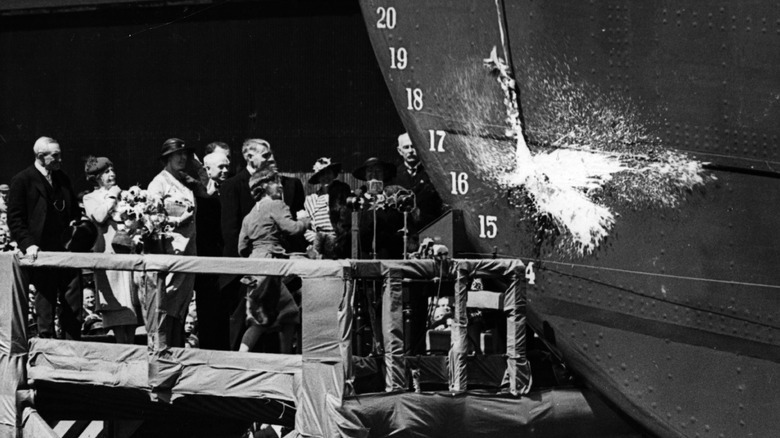The Real Reason Champagne Is Used To Christen Ships
Sailors stand among the most superstitious groups in human history, perhaps only rivaled by baseball players. According to the New Zealand Maritime Museum, the list of things that European sailors once believed would bring bad luck upon a ship and its crew included losing one's hat, stirring tea with a fork, whistling into the wind, and having bananas on board. While we doubt that anyone these days is calling off their voyage over bad fruit juju, sea travel remains deeply entrenched in superstitions and ceremonies that may seem bizarre to the outsider. There is no better example of this than the ceremonial ship launching.
Sail Magazine lays out a few rules to ensure what it calls "a jinx-free first launch," including that you must not speak the name of your boat aloud until you've removed any trace of the old name from the boat, and that you should keep a branch with green leaves on board for the maiden voyage. Of course, the most famous part of the launch ceremony, one often depicted in the media, is shattering a bottle of champagne on the hull of the boat. Considering the lofty prices elicited by Moët & Chandon and the like, this may seem like an extraordinarily wasteful act, but it's a small price to pay when you consider what ships used to be christened with.
Ships were once blessed with blood
Since ancient times, ship launchings have been draped in pageantry. ThoughtCo. recounts how the ancient Egyptians, Greeks, and Romans all held rituals asking the gods to protect sailors on their voyages. The Babylonians used to mark such occasions by sacrificing oxen, the Turks of old would offer the blood of a sheep, and both the Vikings and ancient Tahitians would perform a human sacrifice, per MentalFloss. In Medieval Britain, Christian friars would often christen a boat with holy water, just as they'd do to a child. The heavy religious aspects of ship launching ceremonies began to fade after the European Reformation, but the sense of spectacle lives on.
For a time in the U.K., it was customary to christen a ship with wine. Per the BBC, a representative of the Crown would sip from a silver goblet, spill the remains on the ship's deck, then throw the cup overboard. By the 1700s however, the Royal Navy's fleet was growing so rapidly that wasting a silver goblet on each new ship became prohibitively expensive, and they switched to bottles. 1891 marked the first known use of champagne for the purpose when Queen Victoria christened the HMS Royal Arthur. The BBC notes that champagne not only represents the height of prestige, but its bubbly nature creates a theatrical explosion when the bottle breaks. Sometimes, other sparkling wines like cava may be used, preserving the spectacle without as much strain on the pockets.

